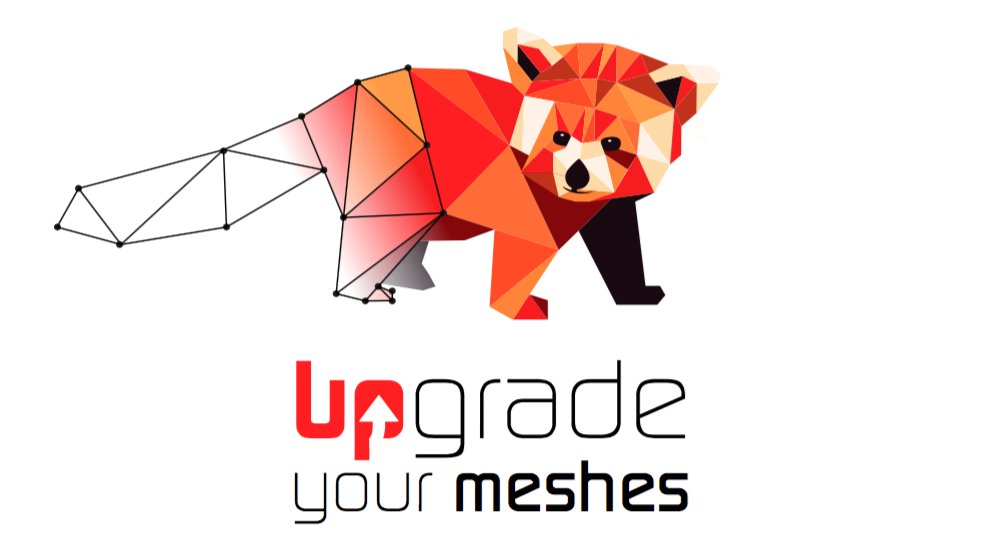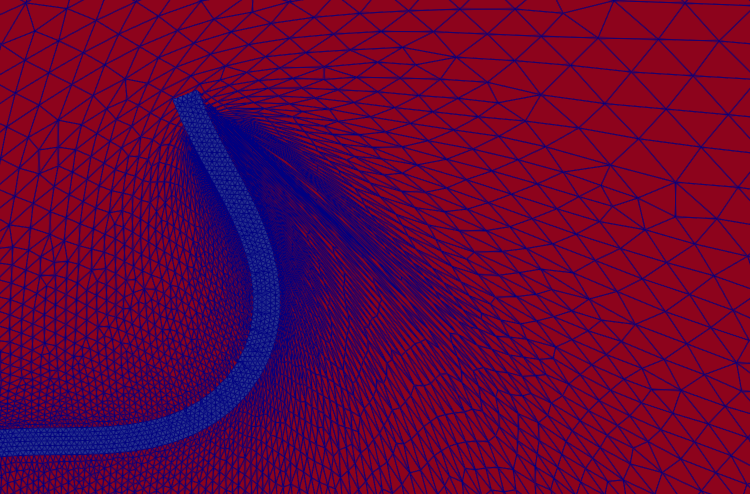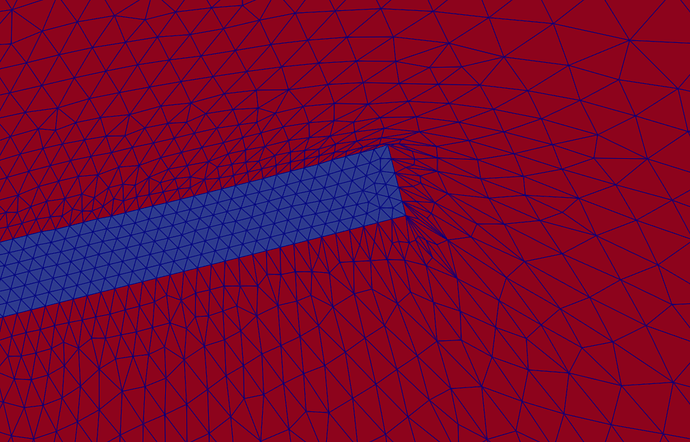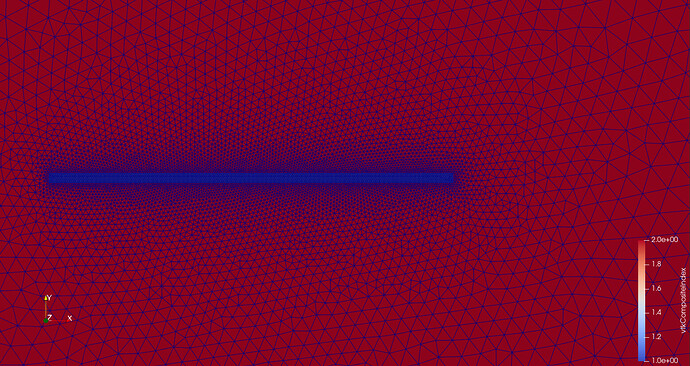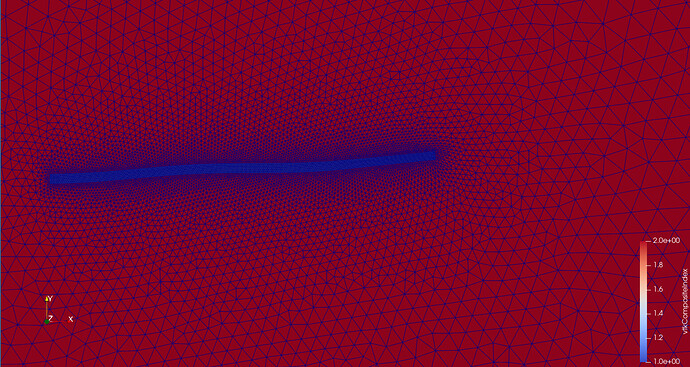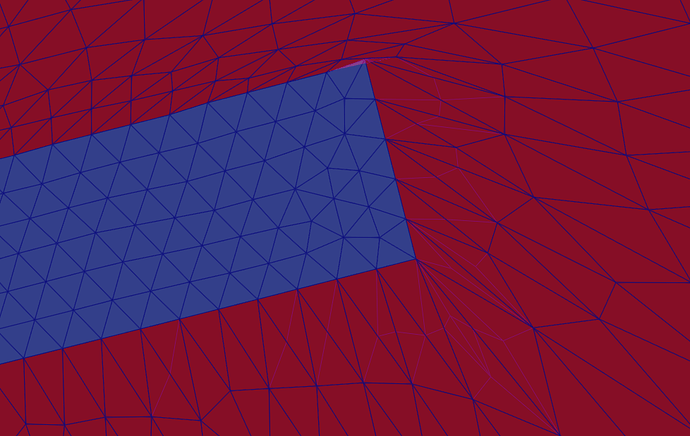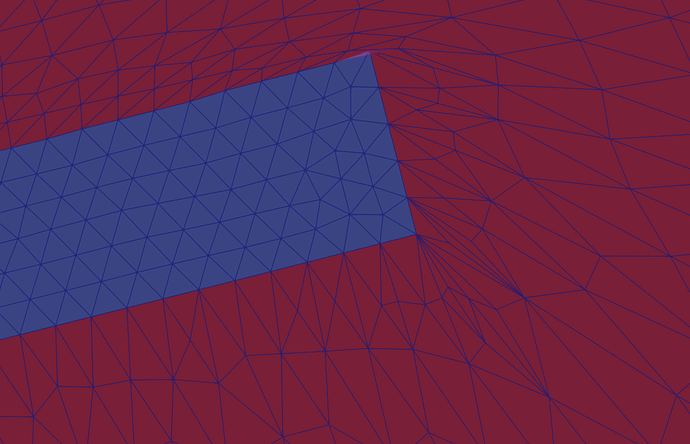@lcirrott setting debug to 1, makes the code to crash
here is the 4th remesh
&&&&&&&&&&&&&&&&&&&&&&&&&&&&&&&&&&&&&&&&&&&&&&&&&&&&&&&&&&&&
MODULE MMG2D: 5.5.2 (Nov. 17, 2020)
&&&&&&&&&&&&&&&&&&&&&&&&&&&&&&&&&&&&&&&&&&&&&&&&&&&&&&&&&&&&
git branch: No git branch found
git commit: No git commit found
git date: No git commit found
– MMG2DLIB: INPUT DATA
– INPUT DATA COMPLETED. 0.000s
MAXIMUM NUMBER OF POINTS (NPMAX) : 50000
MAXIMUM NUMBER OF TRIANGLES (NTMAX) : 100000
– PHASE 1 : DATA ANALYSIS
– MESH QUALITY 15326
BEST 1.000000 AVRG. 0.914612 WRST. 0.002656 (4075)
HISTOGRAMM: 99.27 % > 0.12
96.45 % > 0.5
0.8 < Q < 1.0 13658 89.12 %
0.6 < Q < 0.8 891 5.81 %
0.4 < Q < 0.6 403 2.63 %
0.2 < Q < 0.4 206 1.34 %
0.0 < Q < 0.2 168 1.10 %
** SETTING TOPOLOGY
Connected component or subdomains: 15326
Tagged edges: 23039, ridges: 100, refs: 22939
0 corners, 0 singular points and 7714 non manifold points detected
– RESULTING EDGE LENGTHS 22939
AVERAGE LENGTH 0.1551
SMALLEST EDGE LENGTH 0.0015 5729 3212
LARGEST EDGE LENGTH 1.0000 1638 5728
0.60 < L < 1.30 1073 4.68 %
HISTOGRAMM:
0.00 < L < 0.30 19112 83.32 %
0.30 < L < 0.60 2754 12.01 %
0.60 < L < 0.71 610 2.66 %
0.71 < L < 0.90 455 1.98 %
0.90 < L < 1.30 8 0.03 %
– PHASE 1 COMPLETED. 0.197s
– PHASE 2 : ISOTROPIC MESHING
** GEOMETRIC MESH
** COMPUTATIONAL MESH
** Defining isotropic map
– SIZEMAP CORRECTION : overwritten of sizes at required vertices
– GRADATION : 1.300000 (2.300000)
** Grading mesh
gradation: 0 updated, 1 iter.
** Grading required points.
gradation (required): 6747 updated, 9 iter.
5 splitted
5 splitted, 0 collapsed, 0 swapped
11 splitted
11 splitted, 0 collapsed, 0 swapped
68 vertices moved, 1 iter.
67 splitted, 8 collapsed, 0 swapped, 68 moved
2 edge swapped
88 vertices moved, 1 iter.
24 splitted, 4 collapsed, 2 swapped, 88 moved
1 edge swapped
89 vertices moved, 1 iter.
7 splitted, 6 collapsed, 1 swapped, 89 moved
59 vertices moved, 3 iter.
– PHASE 2 COMPLETED. 0.018s
– MESH QUALITY 15504
BEST 1.000000 AVRG. 0.908374 WRST. 0.001493 (15502)
HISTOGRAMM: 98.94 % > 0.12
95.61 % > 0.5
0.8 < Q < 1.0 13688 88.29 %
0.6 < Q < 0.8 906 5.84 %
0.4 < Q < 0.6 442 2.85 %
0.2 < Q < 0.4 231 1.49 %
0.0 < Q < 0.2 237 1.53 %
– RESULTING EDGE LENGTHS 23206
AVERAGE LENGTH 0.4418
SMALLEST EDGE LENGTH 0.0135 7668 7652
LARGEST EDGE LENGTH 3.2033 309 7723
0.60 < L < 1.30 6019 25.94 %
HISTOGRAMM:
0.00 < L < 0.30 11075 47.72 %
0.30 < L < 0.60 6088 26.23 %
0.60 < L < 0.71 944 4.07 %
0.71 < L < 0.90 985 4.24 %
0.90 < L < 1.30 4090 17.62 %
1.30 < L < 1.41 16 0.07 %
1.41 < L < 2.00 1 0.00 %
2.00 < L < 5.00 7 0.03 %
– MESH PACKED UP
NUMBER OF VERTICES 7803 CORNERS 0
NUMBER OF TRIANGLES 15504
NUMBER OF EDGES 23118
MMG2DLIB: ELAPSED TIME 0.219s
&&&&&&&&&&&&&&&&&&&&&&&&&&&&&&&&&&&&&&&&&&&&&&&&&&&&&&&&&&&&
END OF MODULE MMG2D
